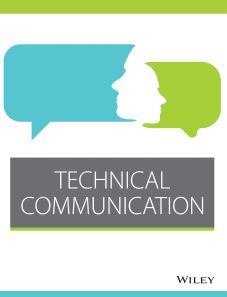Technical Communication
ISBN: 9788126579891
496 pages
Publication Year: 2019
eBook also available for institutional users
For more information write to us at: acadmktg@wiley.com

Description
Technical Communication is a unique and well-structured book that contains best-in-class pedagogy, intending to provide effective communication skills to students in various technical fields. Keeping in mind students belonging to various technical fields, this book has been customised to facilitate students in imbibing them in effective communication skills. This is a ready reckoner which will assist students in their professional fields as well as day-today lives by properly instilling in them the understanding, structure, and usage of the language skills.
Part 1 Grammar at a Glance
Chapter 1 Fundamentals of Grammar
1.1 Articles
1.2 Parts of Speech
1.3 Tenses
1.4 Cause and Effect Expressions
1.5 Auxiliary Verbs
1.6 Modal Verbs and Probability
1.7 If Conditionals
1.8 Gerunds
Chapter 2 Vocabulary Building
2.1 The Concept of Word Formation
2.2 Synonyms and Antonyms
2.3 Technical Vocabulary
2.4 Abbreviations and Acronyms
2.5 Use of Appropriate Vocabulary
2.6 Spelling
2.7 Functional and Lexical Words
Chapter 3 Grammar for Effective Speaking and Writing
3.1 Importance of Proper Punctuation
3.2 Direct and Indirect Speech
3.3 Active and Passive Voice
3.4 Idioms
3.5 Figures of Speech
3.6 Question Forms
3.7 Imperatives
Part 2 Developing Writing Ability
Chapter 4 Basic Writing Skills
4.1 Sentence
4.2 Creating Coherence
4.3 Use of Phrases and Clauses in Sentences
4.4 Organizing Principles of Paragraphs in Documents
4.5 Techniques for Writing Precisely
Chapter 5 Identifying Common Errors in Writing
5.1 Subject–Verb Agreement
5.2 Noun–Pronoun Agreement
5.3 Misplaced Modifiers
5.4 Redundancies
5.5 Clichés
Chapter 6 Technical Writing Skills
6.1 Letter Writing
6.2 Letter of Application – Content, Format
6.3 Report Writing – Types, Structures, Data Collection, Content, Form
6.4 Writing a Proposal
6.5 Recommendations
6.6 Instructions
6.7 Business Communication
Chapter 7 Creative Writing Skills
7.1 Free Writing
7.2 Biographical Writing
7.3 Autobiographical Writing
7.4 Process Description
7.5 Bar Charts and Flowcharts
7.6 Descriptive Writing
7.7 Argumentative Writing
7.8 Essay Writing
7.9 Précis Writing
7.10 Paraphrasing
7.11 Poster Making
7.12 SMS
7.13 Blogs
7.14 Tweets
Chapter 8 The e-English
8.1 Influence of Internet on the English Language
8.2 E-Mail Communication
8.3 Internet Abbreviations
8.4 Blogging
8.5 Challenges of English Language Online
Part 3 Reading and Listening
Chapter 9 Improving Reading Skills
9.1 Skimming and Scanning
9.2 Reading and Note-Making
9.3 Intensive Reading and Predicting Content
9.4 Reading and Interpretation
9.5 Reading – Critical Reading
9.6 Hints Development
Chapter 10 Listening Skills
10.1 Listening Comprehension
10.2 Difference between Listening and Hearing
10.3 Types of Listening
10.4 Types of Listening Intensity
10.5 Effective Listening
10.6 Ways to Improve Listening Skills
10.7 Listening and Note-Taking
10.8 Barriers to Effective Listening
Part 4 Verbal and Non-Verbal Communication
Chapter 11 Process of Communication and Effective Speaking
11.1 Communication Process
11.2 Barriers to Effective Communication
11.3 Flow of Organizational Communication
11.4 Language as a Tool of Communication
11.5 Pronunciation, Intonation, Stress and Rhythm
11.6 Introduction to Phonetics
11.7 Non-Verbal Communication
11.8 Verbal/Oral Communication
11.9 Communication at Workplace
11.10 Public Speaking
11.11 Persuasive Speaking
11.12 Impromptu Speaking – Extempore
11.13 Just a Minute
11.14 Debate
11.15 Conversations and Dialogues
11.16 Conversation over Telephone
Chapter 12 Soft Skills
12.1 Be Soft Skills Savvy
12.2 Intrapersonal Skills
12.3 Interpersonal Skills
12.4 Verbal Skills
12.5 Non-Verbal Skills
12.6 Correlating Verbal and Non-Verbal Communication
Conclusion
Practice Questions
Useful Resources
Appendix A: Commonly Confusing Words
Appendix B: Words in British and American English
Appendix C: List of Abbreviations and Acronyms
Appendix D: Single Word Substitution
Appendix E: Cluttering Phrases
Appendix F: Synonyms and Antonyms
Appendix G: Samples of Curriculum Vitae
Appendix H: Twitter Acronyms, Abbreviations and Initialisms
Index

